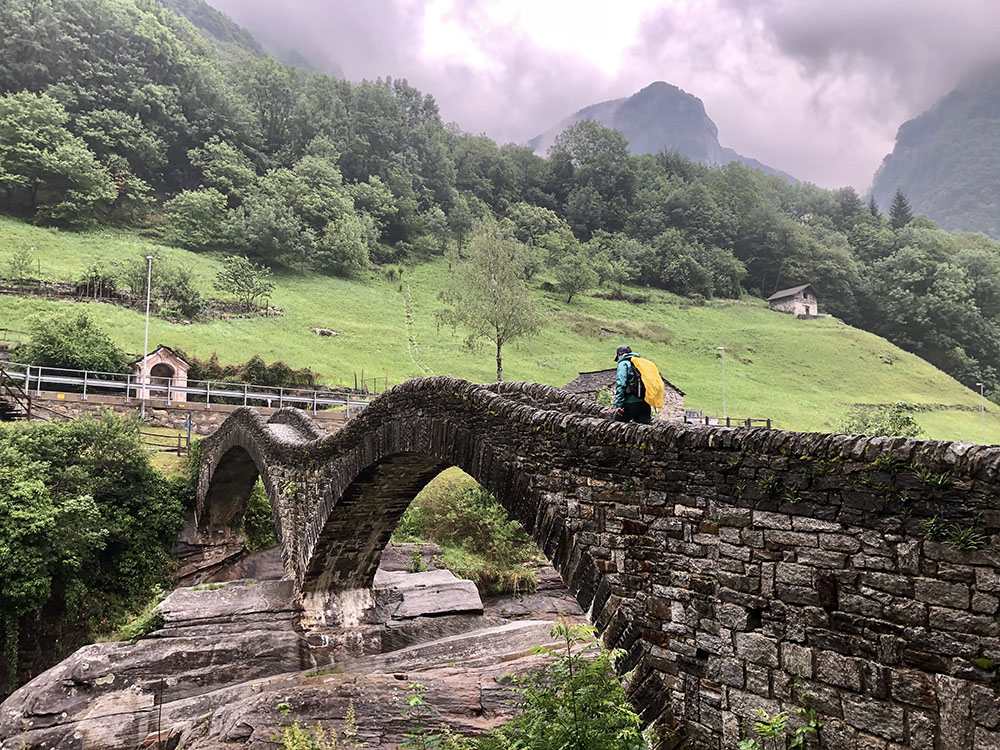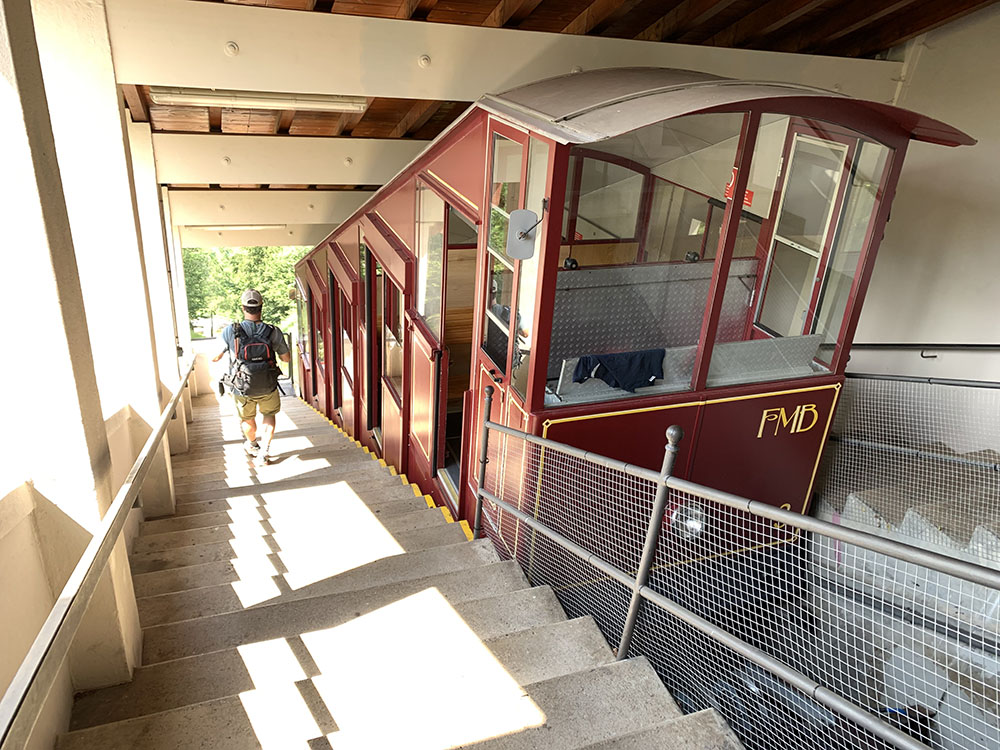
Charming antique villages and cable car rides, gourmet cheeses and chocolates, a hiking trip to the lakes district of Ticino, Switzerland is like taking a step back in time to old world Europe. Located along the southern border of the country and bumping up against Italy, breathtakingly beautiful Ticino is more Mediterranean in both its climate and its vibe than the country’s more mountainous zones to the west. It get warmer earlier here and stays warmer longer, a fact reflected in the palm trees you’ll find dotting the shore of the vibrant Lugano, a bustling lakeside city you’ll visit along your way. This is also the Italian pocket of this quadrilingual country (the others being French, German, and Romansh), so strassi (street) becomes via and plaza (square) becomes piazza.
Hiking in Ticino
There are few countries in the world that rival Switzerland’s network of hiking trails. Indeed, if you’re looking for one of the best places to go hiking in the world, look no further. In Ticino, the hiking is mellower than that of the Swiss Alps (hikes never exceed 3,414 feet in elevation gain and 10 miles in length on this trip), yet is no less beautiful.
Blessed by glaciers, lakes, and a diverse collection of plants and wildlife, the area is one of the best places in Europe to stage a multi-day hiking adventure. You’ll wander through tiny alpine herding hamlets along the riverbanks of the emerald-colored waters of the Verzasca River in the ancient village of Lavertezzo. You’ll stroll the shops—gelato in hand—on Lugano’s promenade. And you’ll have the chance to summit Mount Tamaro and Mount Lema (5000 feet). On the traverse between these two peaks, there are spectacular views of the valleys and lakes of Locarno and Lugano as well as a stop to the beautiful Santa Maria degli Angeli church.
Transportation in Ticino
 One of the best parts of traveling to this part of Switzerland is the transportation connecting your hiking journey. Swiss trains, known for their engineering, are positioned to travel through some of the most exquisite scenery in Europe. Lugano, for instance, lies at the intersection of the William Tell Express and the Bernina Express, two of Switzerland’s most famous rail lines. The William Tell ride, which is actually a mash-up of boat-rides and rail riding, carries you across the pretty Lake Luzern before carting you up the enchanting Gotthard pass. On the Bernina Express, you’ll see everything from the diverse vegetation of the lake district to the waterfalls and rugged landscape of the more mountainous Pontresina.
One of the best parts of traveling to this part of Switzerland is the transportation connecting your hiking journey. Swiss trains, known for their engineering, are positioned to travel through some of the most exquisite scenery in Europe. Lugano, for instance, lies at the intersection of the William Tell Express and the Bernina Express, two of Switzerland’s most famous rail lines. The William Tell ride, which is actually a mash-up of boat-rides and rail riding, carries you across the pretty Lake Luzern before carting you up the enchanting Gotthard pass. On the Bernina Express, you’ll see everything from the diverse vegetation of the lake district to the waterfalls and rugged landscape of the more mountainous Pontresina.
The tram rides, or cable cars, of Switzerland are equally impressive. On many of the hikes planned on this Ryder Walker journey, you’ll have the chance to ride up (or down) the tram line. Not only do trams save your legs for future journeys, they also carry you to the “good stuff” quickly. Along the way, you’ll see the same magnificent views that the trains afford you: glacially carved valleys, lush river beds, and snow-capped peaks.
The Food of Ticino
You’ll find all of the same goodies the Swiss enjoy here—the cheesy, melted goodness of their fondues and raclettes, their rösti hash browns, their delicious chocolates—yet with the Italian influence, you’ll also find some fun surprises. In addition to the typical pastas, pizzas, and gelatos, you’ll encounter dishes like polenta, which is often served with roast beef or the local Luganighe sausage. You’ll also find yummy cured meats like bündnerfleisch, a dried beef. Capuns, egg wrapped in Swiss chard and baked and served with local meats, are another popular item; indeed, every town seems to have their own special version of this. Finally, you’d be remiss if you didn’t top off a meal with bündner nusstorte, the Swiss’s famous caramelized, nut-filled pastry.
Switzerland’s Culture and History
 Switzerland’s identity is perhaps best summed up by its license plate initials, CH, which stands not for “chocolate,” but for the Latin name for Swiss Confederation, Confoederatio Helvetica. It is a confederation of cantons, state-like regions, each of which preserve their own individuality and language. By refusing to use any one language and using Latin instead, the government embraces them all. This love for peace is a reflection of the Swiss’s past and current history as well.
Switzerland’s identity is perhaps best summed up by its license plate initials, CH, which stands not for “chocolate,” but for the Latin name for Swiss Confederation, Confoederatio Helvetica. It is a confederation of cantons, state-like regions, each of which preserve their own individuality and language. By refusing to use any one language and using Latin instead, the government embraces them all. This love for peace is a reflection of the Swiss’s past and current history as well.
While the rest of the war erupted in 2 world wars, the Swiss remained fiercely neutral. To this day, they maintain one of the world’s best militaries, but they will rarely use it, preferring to promote peace through their heavy involvement in organizations like the U.N., International Red Cross, and the World Health Organization. They also give huge subsidies to farmers, so that farmers can compete against goods produced in a global marketplace: the Swiss want the Swiss way of life to endure, complete with its hundreds of varieties of locally-made cheeses.
All of this is good news for the traveler in Switzerland. While on the Ryder-Walker adventure to Ticino, you’ll enjoy everything anyone has ever loved about the place: its lush rolling valleys, its hearty, delicious cuisine, the clang of cow-bells from nearby farms, and the view of the mountains that surround, all preserved beautifully for future generations.
For more information, visit Ryder Walker’s Ticino: Swiss Lakes District trek page.









Comments are closed.